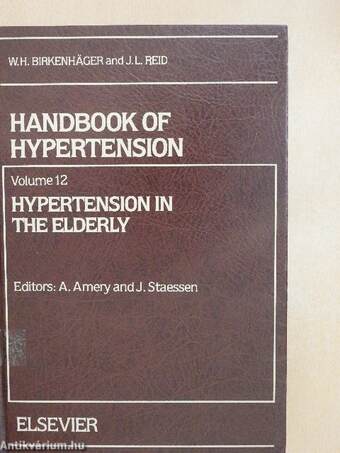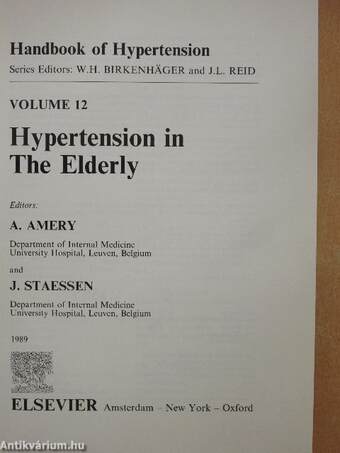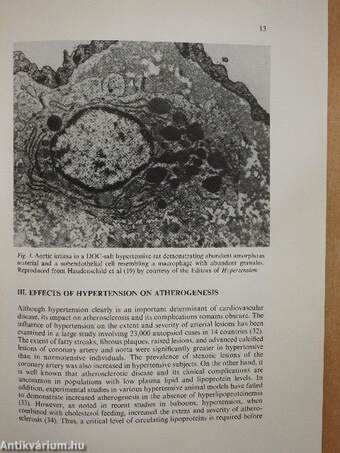1.116.679
kiadvánnyal nyújtjuk Magyarország legnagyobb antikvár könyv-kínálatát
Hypertension in the Elderly
| Kiadó: | Elsevier |
|---|---|
| Kiadás helye: | Amsterdam-New York |
| Kiadás éve: | |
| Kötés típusa: | Fűzött keménykötés |
| Oldalszám: | 426 oldal |
| Sorozatcím: | Handbook of Hypertension |
| Kötetszám: | 12 |
| Nyelv: | Angol |
| Méret: | 25 cm x 17 cm |
| ISBN: | 0-444-90471-9 |
| Megjegyzés: | Fekete-fehér fotókkal, ábrákkal. További szerzők a könyvben. |
naponta értesítjük a beérkező friss
kiadványokról
naponta értesítjük a beérkező friss
kiadványokról
Előszó
Foreword
The twelfth volume in this series is on 'Hypertension in The Elderly', i.e. in people over 60 years of age. The concept of the Handbook of Hypertension developed in the late 1970s from... Tovább
Előszó
Foreword
The twelfth volume in this series is on 'Hypertension in The Elderly', i.e. in people over 60 years of age. The concept of the Handbook of Hypertension developed in the late 1970s from a widespread feeling that the diversity of interests and inputs into hypertension research did not lend themselves to publication in a single textbook. The Handbook is recognized as an authoritative source of information and reviews on clinical and research aspects of high blood pressure. It has now come of age in more than one sense in this volume which considers the problems of hypertension in the aged.
The scope of hypertension in man has developed over the last 30 years from the short-term care of a small number of hospitalized patients with severely elevated blood pressure and extensive»target-organ failure to a major long-term community-health problem involving a substantial proportion of the population. It appeared possible at one time that the mechanisms involved in the pathogenesis of hypertension could be identified by a limited number of circumscript and straightforward experiments in laboratory animals. This is clearly not so. The field of experimental hypertension has, if anything, expanded even more than clinical practice.
We shared with our Publishers the view that the accumulation of biological and clinical knowledge in the field of hypertension had outgrown the limitations of the classical monograph. Moreover, the subject of hypertension by its very nature is a multidisciplinary one, attracting such diverse professionals as biochemists and public health workers, in addition to clinicians. When one tries to envisage what would happen to a single all-encompassing book, it is clear that it could never satisfy the different groups involved in high blood pressure. Some sections would become outdated rapidly while others would have a longer lifespan. An alternative, to escape from the constraints of a single textbook and to reconcile the interests of both generalists and specialists, was to choose the format of a serial handbook.
The series as it stands has resulted from lengthy discussions with clinicians and scientists. We believe that it will be of interest to many dilferent groups including clinical investigators, house officers, general practitioners, pharmacologists, pharmacists, biological scientists, physiologists and epidemiologists.
The present volume addresses the topic of Hypertension in The Elderly. With an aging population and a very high prevalence of hypertension and vascular disease in people over 60 years of age, the timing is appropriate. This volume presents a comprehensive review of the field, including aging and the circulation, the epidemiology of hypertension in the elderly, treatment alternatives based on drug and non-drug approaches, and the results of major intervention trials.
Titles of further volumes currently in preparation are;
Management of the Hypertensive Patient (Editors: F.R. Buhler and J.H. Laragh)
xi Vissza
Tartalom
Contents
Foreword xi
W.H. Birkenhäger and J.L. Reid
Introduction xiii
A. Amery and J. Staessen
I. Aging and circulatory control in the normotensive and hypertensive states
1. Structural changes in the heart with functional implications 1
F. Fouad-Tarazi and B. Healy
2. Arterial wall characteristics in hypertension and aging 8
A.V. Chobanian
3. Aging and the baroreflex 24
J.M. Karemaker, W. Wieling and A.J. Dunning
4. Alterations in reflex control of the circulation associated with aging 39 A.U. Ferrari, G. Grassi and G. Mancia
5. «-Adrenoceptors, /^-adrenoceptors and aging 51
C.P. Nielson and R.E. Vestal
6. Systemic hemodynamics 63
G.E. Garavaglia, C.J. Lavie and F.H. Messerli
7. Blood pressure in relation to physical aging processes in the arterial
wall 70
M.E. Safar and G.M. London
8. The influence of aging on catecholamine metabolism 85
M. Esler, G. Lambert and G. Jennings
9. The impact of senescence on the renal vasculature and renin
secretion 99
P.W. de Leeuw and W.H. Birkenhäger
10. Age-related changes in renal function 119
J. Lowenstein
11. Extracellular fluid volume regulation: role in the pathogenesis,
maintenance and treatment of hypertension in the elderly 131
M.H. Weinberger
XV
12. General pathophysiological considerations 143
M. Epstein and J.R. Osier
II. Demographic aspects of hypertension with emphasis on older age groups
13. Definition, prevalence and incidence of hypertension in the elderly 153 CJ. Bulpitt
14. Systolic blood pressure as a risk factor 170
W.H. Birkenhäger and P. W. de Leeuw
15. Impact of high blood pressure on morbidity and mortality 174
K. Ueda. T. Omae, Y. Hasuo and Y. Kiyohara
III. Pharmacokinetics and pharmacodynamics of the main hypotensive drugs in the elderly
16. Pharmacokinetics in the elderly 186
K. O'Malley and J.G. Kelly
17. Thiazide diuretics and potassium-sparing agents 195
J.B. Rosenfeld and J. Zabludowski
18. Pharmacodynamics and pharmacokinetics of /J-adrenoceptor
blockers in the elderly 204
B.N.C. Prichard, C.W.L Owens and J.M. Cruickshank
19. a-Adrenoceptor blockers in the elderly 213
P.A. van Zwieten, G.J. Blauw and P. van Brummelen
20. Centrally acting drugs 222
M.A. Weher
21. Calcium antagonists (calcium-entry blockers): general considerations 245 P.A. van Zwieten, G.J. Blauw and P. van Brummelen
22. Calcium antagonists in the treatment of arterial hypertension in the elderly 258
G. Leonetti
23. Converting-enzyme inhibitors in elderly hypertensive patients 268
H.R. Brunner, B. Wae her and J. Nussberger
IV. Effects of treatment in prospective trials
24. The Veterans Administration Cooperative Study on Antihypertensive Agents 281
E.D. Preis
25. The Hypertension Detection and Follow-up Program 288
N.O. Borhani and M.H. Maxwell
xiii
26. The Australian National Blood Pressure Study 298
G.E. Bauer
27. The trial by the European Working Party on High Blood Pressure in
the Elderly 308
A.F. De Schaepdryver and A. Amery
28. Epidemiology of treated and untreated hypertension in the elderly 320 J. Staessen, R. Van Hoof, R. Fagard and A. Amery
V. Therapeutic approaches
29. Non-pharmacological reduction of blood pressure in the elderly 352 J.F. Potter and G.D. Beevers
30. Choice of antihypertensive drugs in the elderly 368
P.O. Simpson
31. Compliance with antihypertensive treatment in the elderly 387
C.J. Bulpitt and A.E. Fletcher
Index 399 - 426
Témakörök
- Orvostudomány > Kórélettan
- Idegennyelv > Idegennyelvű könyvek > Angol > Orvostudomány
- Orvostudomány > Általános orvosi, egyéb > Idegennyelvű
- Orvostudomány > Általános orvosi, egyéb > Kutatások, kísérletek
- Orvostudomány > Belgyógyászat > Általános > Idegennyelvű
- Orvostudomány > Belgyógyászat > Általános > Terápia
- Orvostudomány > Belgyógyászat > Általános > Betegségek > Szív- és érrendszeri
- Orvostudomány > Orvosi idegennyelvű könyvek > Általános orvosi
- Orvostudomány > Orvosi idegennyelvű könyvek > Belgyógyászat
- Orvostudomány > Orvosi idegennyelvű könyvek > Kórélettan









